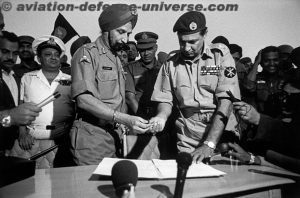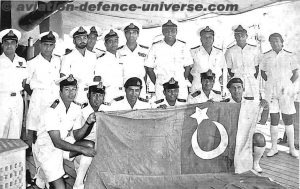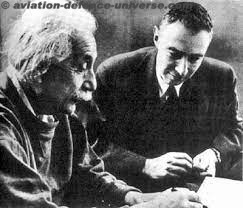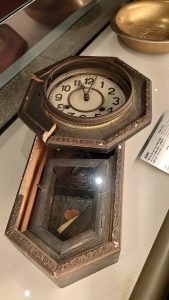
- Atomic Bomb changed the face of war forever
- The threat of which still looms large over the world
By Sangeeta Saxena
New Delhi. 09 August 2022. 77 years ago when Hiroshima was a city just converted into rubble, Japan was in the biggest shock and the world in horror over the new bomb , it’s reach and effect, Nagasaki the shipbuilding Centre nestled amidst hills, heard a huge blast and saw a mushroom cloud at 11.02 AM on 09 August 1945. USA had dropped the second nuclear bomb over this bustling industrial town of which resulted finally in Japan’s unconditional surrender and the end of World War II.
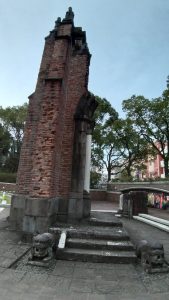
Probably the devastation at Hiroshima was not an eye opener to convince the Japanese War Council to accept the Potsdam Conference’s demand for unconditional surrender. So US had a backup plan of dropping the second atomic bomb named “Fat Man,” on August 11, but bad weather made them advance their plan to August 9th. A specially adapted B-29 bomber, called “Bockscar,” took off from Tinian Island under the command of Maj. Charles W. Sweeney dropped the bomb 1,650 feet above the city with an equivalent force of 22,000 tons of TNT. The hills surrounding Nagasaki contained the destructive force killing between 60,000 and 80,000 .
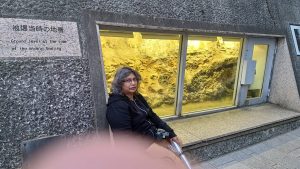
The hypocenter of the explosion was the Urakami district which in addition to being an industrial zone was also home to the Nagasaki Medical College and was Japan’s second oldest port open to foreign trade. When the bomb was dropped 20 neighborhoods within a one-kilometer radius of the hypocenter were completely destroyed by the heat flash and blast winds generated by the explosion. They were then reduced to ashes by the fires which followed. Within 2 km of the hypocenter, roughly 80% of the houses collapsed and burned. When the smoke cleared, the area was strewn with corpses. The yield of the explosion was later estimated at 21 kilotons, 40 percent greater than that of the Hiroshima bomb.
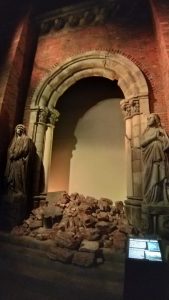
peace museum
Very few know that Mitsubishi-Urakami Torpedo Works, 1,400 feet north of ground zero, Nagasaki made torpedoes used in the attack on Pearl Harbor . In 1945 Nagasaki was an industrial center and major port on the western coast of Kyushu. A small conventional raid on Nagasaki on August 1st had resulted in a partial evacuation of the city, especially of school children. There were still almost 200,000 people in the city below the bomb when it exploded. The atomic bomb detonated almost exactly between two of the principal targets in the city, the Mitsubishi Steel and Arms Works to the south, and the Mitsubishi-Urakami Torpedo Works to the north.
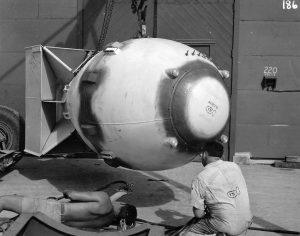
Although the destruction at Nagasaki has generally received less worldwide attention than that at Hiroshima, it was extensive nonetheless. “Fat Man” leveled much of Nagasaki’s residential wooden buildings, leaving only a few of the city’s reinforced concrete buildings damaged but standing. Nagasaki was never in the initial list of US targets. But U.S. Secretary of War Henry Stimson wanted Kyoto removed from the target list, on the grounds that the city was too culturally significant to the Japanese to be destroyed.
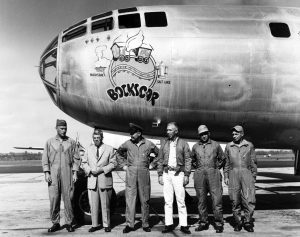
Some say his personal fondness for the city—he visited in the 1920s and may have honeymooned there—was the real reason he appealed to President Harry Truman to remove Kyoto from the list. A replacement was not selected until the day before the official strike orders were issued. On July 24, 1945, a hand-written notation—“and Nagasaki”—appears on a draft of the strike order. It was officially added on July 25.
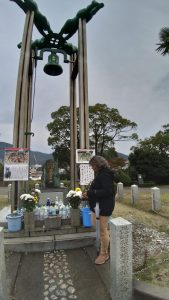
Nagasaki Peace Park
Surprisingly for strategists in US it should have been a primary choice as it had a major defence set up with defence manufacturing units. City Air Defense Headquarters, City Air Defense Patrol Headquarters, Nagasaki Prefecture Guard Unit, Sasebo Naval Guard Unit Nagasaki Guard Unit, Nagasaki Fortress Headquarters, Nagasaki Regiment District Headquarters, Nagasaki Military Police Squad, Nagasaki Naval Office, Western Armed Forces 2739th Unit, Western Armed Forces 2781st Unit, Mitsubishi Nagasaki Shipyard, Mitsubishi Nagasaki Steelworks, Mitsubishi Nagasaki Arms Factory, Mitsubishi Nagasaki Electric Works, Mitsubishi Nagasaki Shipyard Saiwaimachi Factor, Kawanami Industries, Kawanami Industries Fukahori Shipyard, Nagasaki City Defense Unit Headquarters, Western Armed Forces Fukuoka POW Camps, Enemy Detention Camp , Western Armed Forces 8064th Unit, Western Armed Forces 9764th Unit, Nagasaki Joint Steamship Co. were some of them.
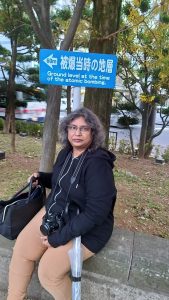
Ground Zero Nagasaki
The number of air-raid alerts and air-raid alarms issued in the city of Nagasaki from the outbreak of war between Japan and the Allies until August 16, 1945 were 1942: seven air-raid alerts and two air-raid alarms, 1943: four air-raid alerts, 1944: 15 air-raid alerts and ten air-raid alarms and 1945: 149 air-raid alerts and 77 air-raid alarms 48.
During this period Nagasaki City experienced six actual air raids, the last of which was the atomic bombing. The dates and targeted districts were on August 11, 1944, urban area, followed by April 26 and July 29, 1945, waterfront docks , on July 31, 1945, Kawanami Shipyard, on August 1, 1945, Mitsubishi Nagasaki Shipyard and the railroad switchyard and the last one was on August 9, 1945 (the atomic bombing), urban area.
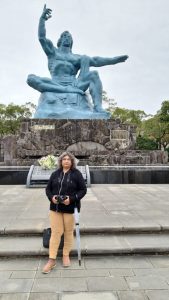
Monument
In November 2019 ADU on it’s battle tracking of World War II battle fields, decided on to Nagasaki . Many disagreed with my concept of calling it a battle field but the truth is it was the final battle field putting an end to World War II . The only difference was that the field had no military force to combat the terror from the skies.
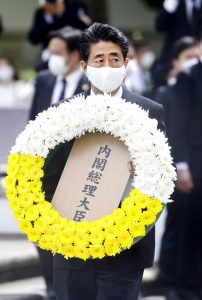
In 2020 on the 75th anniversary of the atomic blast, the then Japanese Prime Minister Shinzo Abe was at Nagasaki Peace Memorial Park to pay homage to the victims of the atomic bombing 75 years ago.
The Mayor of Nagasaki, Tomihisa Taue, urged world leaders to ban nuclear weapons during the ceremony. He also called on Japan’s government to sign the Treaty on the Prohibition of Nuclear Weapons, saying the threat of the further use of nuclear arms was growing more than ever.
“If, as with the novel coronavirus, which mankind did not fear until it spread to our immediate environment, we only become aware of the threat of nuclear weapons when they are used again, we are in an irrevocable position,” said Taue.
UN Secretary General Antonio Guterres, in a message read by his undersecretary Izumi Nakamitsu, said, “The historic progress in nuclear disarmament is in jeopardy. Because of COVID-19 restrictions only 500 persons were present at the ceremony in the Nagasaki Peace Park.
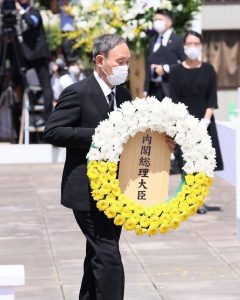
Japanese Prime Minister Suga in a FaceBook post stated, ” Seventy-seven years ago today, the city of Nagasaki was reduced to ashes in an instant by an atomic bomb. Yet through the extraordinary efforts of its citizens, it achieved reconstruction beautifully as an International Culture City symbolizing peace and culture. I felt strongly once again that there is no trial that cannot be overcome and felt acutely how precious peace is. In Nagasaki, I pledged that Japan will make its utmost efforts for the realization of a world free of nuclear weapons and for the realization of eternal world peace. I offered my heartfelt prayers for the repose of the souls of those who fell victim to the atomic bombing and prayed sincerely for the inner peace of the bereaved families and the atomic bomb survivors as well the people of Nagasaki City.”






































